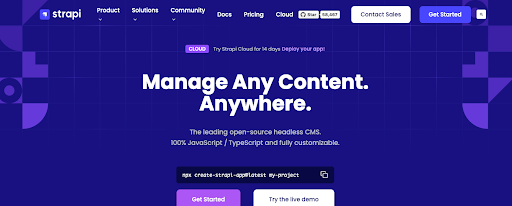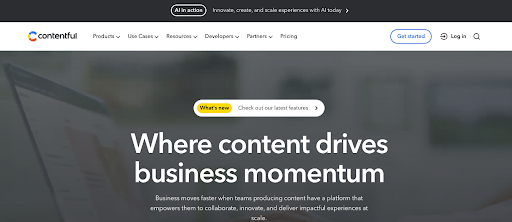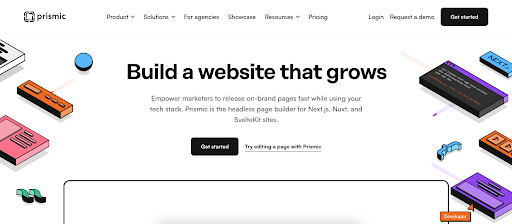Creating dynamic and feature-rich applications has become a standard in the ever-evolving web development landscape. Among the myriad tools available, the combination of Next.js, a robust React framework, and a headless CMS (Content Management System) stands out as a dynamic duo, especially when considering their seamless integration for next.js e-commerce, next.js website development and efficient Next.js hosting solutions.
This blog will take you through the best headless CMS options and why Next.js and aim to uncover the best fit for Next.js applications, focusing on their applicability in Next.js e-commerce and building compelling Next.js websites.
What is Headless CMS?
Headless CMS separates the content creation and management process from its presentation on the front end. It provides an API that developers can use to fetch and display content in their applications. This decoupling allows for greater flexibility and scalability in the development process, especially when using Next.js file structure and integration capabilities. Next.js, with its structured file organization, Next.js facilitates seamless integration with headless CMS solutions, enabling developers to retrieve and display content in their Next.js applications efficiently.
What is Next.js?
Next.js is a React framework that facilitates the creation of dynamic web applications. Known for its server-side rendering (SSR), static site generation (SSG), and seamless integration with React, Next.js has gained popularity as an ideal choice for building modern web applications.
Best Headless CMS for the Next.js App
1. Strapi

Strapi has emerged as a robust open-source headless CMS, offering flexibility and extensibility. It provides a user-friendly interface for content creation and management and a RESTful API and GraphQL support. Strapi's extensibility through plugins and customizable API endpoints makes it a compelling choice for Next.js applications.
2. Contentful

Contentful is a cloud-based headless CMS known for its developer-friendly approach and versatile content modeling. It provides a robust RESTful API and GraphQL endpoint, enabling developers to fetch content easily. Contentful's web app allows for efficient content creation, making it accessible to technical and non-technical users.
When paired with Next.js, Contentful offers a straightforward integration process. Developers can access the Contentful SDK or the fetch API to retrieve and render content in their Next.js components. Contentful's support for webhooks and real-time updates ensures that content changes are reflected dynamically in the Next.js application.
3. Sanity

Sanity is a headless CMS focusing on structured content and real-time collaboration. It offers a customizable content studio for content creation and a powerful API for fetching data. Sanity's flexibility in content modeling allows developers to create rich data structures tailored to their application's needs.
Integrating Sanity with Next.js is a breeze, thanks to Sanity's official client library for JavaScript. Developers can use the library to fetch data from Sanity and render it in their Next.js components. With support for real-time updates, developers can build dynamic and reactive user interfaces that instantly respond to content studio changes.
4. Prismic

Prismic is a headless CMS focusing on content relationships and rich media handling. It provides a RESTful API and GraphQL support, allowing developers to choose the querying method that best fits their needs. Prismic's content modeling is intuitive, making it easy for creators to structure and organize their content.
Next.js and Prismic work seamlessly together, with Prismic providing a JavaScript development kit for easy integration. Developers can use the kit to query content from Prismic and render it in their Next.js components. Prismic's slice-based approach to content modeling aligns well with React components, simplifying the process of building dynamic layouts.
Comparative Analysis
We have explored some of the best headless CMS options for Next.js. Let's compare them based on the critical criteria:
Ease of Use:
Strapi: Known for its user-friendly interface, Strapi makes content creation and management accessible to technical and non-technical users.
Contentful: With a clean and intuitive web app, Contentful simplifies content creation, ensuring teams can efficiently collaborate.
Sanity: While focused on structured content, Sanity offers a user-friendly content studio that facilitates content creation and collaboration.
Prismic: Prismic's intuitive content modeling and slice-based approach make it easy for content creators to structure and organize content.
Flexibility and Extensibility:
Strapi: Strapi's extensibility through plugins and customizable API endpoints allows developers to tailor the CMS to their specific requirements.
Contentful: Known for its developer-friendly approach, Contentful allows for easy customization and extends functionality through webhooks and integrations.
Sanity: Focusing on structured content, Sanity provides flexibility in content modeling, allowing developers to create rich data structures for their applications.
Prismic: Prismic's content relationships and rich media handling offer flexibility in content modeling, enabling developers to build diverse and feature-rich applications.
Integration with Next.js:
Strapi: Integrating Strapi with Next.js is straightforward, thanks to its flexible API. The compatibility of content types and relationships with React components ensures a smooth development process.
Contentful: Contentful's SDK and API make integration with Next.js seamless. Real-time updates and webhooks provide dynamic content rendering in Next.js applications.
Sanity: Sanity's official client library simplifies the integration process with Next.js. Real-time updates enable developers to build reactive user interfaces.
Performance:
Strapi: Strapi's performance is robust, and its RESTful API ensures efficient data retrieval for Next.js applications.
Contentful: Contentful's cloud-based infrastructure contributes to reliable performance, and its CDN ensures fast content delivery.
Sanity: Sanity's real-time updates and efficient API contribute to a performant user experience in Next.js applications.
Conclusion
Choosing the best headless CMS for a Next.js application depends on specific project requirements, team expertise, and the desired user experience. Each CMS discussed—Strapi, Contentful, Sanity, and Prismic—offers unique strengths that cater to different needs.
Choose Strapi if:
- You prioritize an open-source solution.
- Customization and extensibility are crucial for your project.
- A user-friendly interface for content creators is essential.
Choose Contentful if:
- You prefer a cloud-based solution with a developer-friendly approach.
- Real-time updates and webhooks for dynamic content are priorities.
- Efficient collaboration between technical and non-technical users is crucial.
Choose Sanity if:
- You prioritize structured content and real-time collaboration.
- Flexibility in content modeling is a key requirement.
- A user-friendly content studio for content creators is important.
Choose Prismic if:
- You focus on content relationships and rich media handling.
- A slice-based approach to content modeling aligns with your development process.
- Seamless integration with Next.js using a JavaScript development kit is desirable.
Ultimately, the best choice depends on your specific project goals and the features that align with your team's preferences and expertise. As the web development landscape continues to evolve, exploring and experimenting with different combinations will lead to discovering the perfect pair for your Next.js react native application.
Subscribe to Saffron Tech
Explore your marketing zen with our newsletter! Subscribe now.



